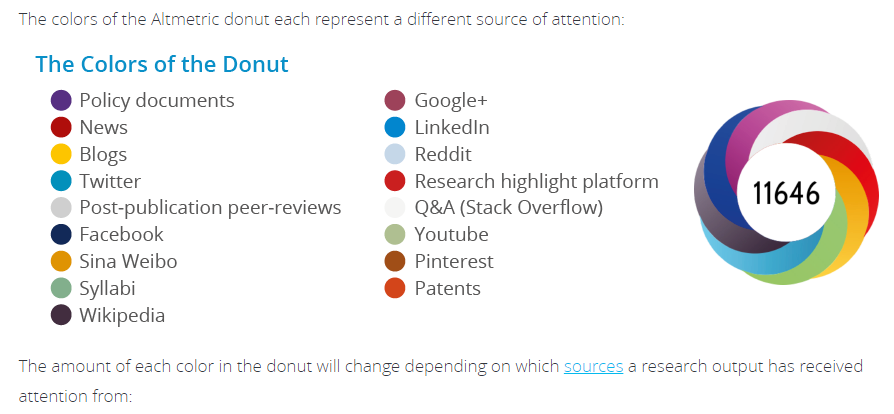Altmetrics
Stephanie Jacobs and Catherine Radbourne

Traditional, citation-based metrics can take a significant amount of time to indicate the reach of a researcher’s work. Altmetrics are non-traditional metrics that can indicate the level of attention researcher’s work is attracting online. While Altmetrics do not necessarily indicate how highly cited a researchers’ work will be, they can give researchers an early signal of the potential citations of their research.
Getting Started
Altmetrics are defined as “…metrics and qualitative data that are complementary to traditional, citation-based metrics.”
Altmetrics may include:
- number of article views
- number of downloads in an institutional/preprint repository
- number of times an article has been added to an online reference manager (e.g. Mendeley)
- number of tweets about a work
- number of Facebook posts
- number of mentions in news sources
- number of patents and patent citations
- number of data citations
- number of blog posts from individuals and organisations
- number of mentions in policy documents.
Basically, anything with a persistent identifier (like a DOI, ISBN, SSRN ID, etc) can be tracked.
Altmetrics are especially helpful to researchers with non-traditional research outputs, such as those in the discipline and Creative Industries.
Altmetrics can also be used to support impact and engagement claims, which is particularly helpful when applying for research grants. For example:
Professor Y’s research influenced the government policy in several countries leading to better patient outcomes in the area of… Their research was reported by news media agencies in country H, which resulted in further industry engagement and led to the creation of…
Like any metric, there are limitations that exist with altmetric data. Use of these to support any claims of the reach and impact of a person’s research, should be done in conjunction with other quantitative and qualitative measures. Read this report from Mike Thelwall on The pros and cons of the use of altmetrics in research assessment for more detail on altmetrics.
 Exercise: Before moving on to the next section, make a list of as many places as possible on the web that might feed into Altmetrics. Try to be as specific as possible about the website or platform.
Exercise: Before moving on to the next section, make a list of as many places as possible on the web that might feed into Altmetrics. Try to be as specific as possible about the website or platform.
Learn More
Altmetric Explorer
Altmetric is a system that tracks the attention that research outputs, such as scholarly articles and data sets, receive online. It pulls data from:

- Social media
- E.g. Twitter, Facebook.
- Traditional media
- Mainstream (The Guardian, New York Times)
- Field specific (New Scientist, Bird Watching)
- Many non-English language titles covered
- Blogs
- Major organisations (Cancer Research UK)
- Individual researchers
- Online reference managers
- E.g. Mendeley, CiteULike.
Altmetric cleans up and normalizes the data from these sources then makes it available for analysis. A key difference between Altmetric and other social media monitoring services is that Altmetric will disambiguate links to outputs: it knows that even though some tweets might link to a PubMed abstract, newspapers to the publisher’s site and blog posts to a dx.doi.org link, they’re all talking about the same paper.
Below are all of the sources that Altmetric Explorer can provide metrics for.

Source: https://www.altmetric.com/about-our-data/the-donut-and-score/
Altmetric Explorer data can be seen for free at article level but to see an overview of a researcher’s outputs, you must have a subscription.
PlumX Metrics

PlumX Metrics are from Elsevier and is another subscription tool that provides altmetric data. It labels the data differently from Altmetric Explorer, preferring the terms Usage (green), Captures (purple), Mentions (yellow), Social Media (blue) and Citations (red). A further breakdown of what is tracked in each of these areas can be found at Elsevier’s help page or on the Plum Analytics, About PlumX Metrics page.
The Plum Print circles (like the colours in Altmetric Explorer’s doughnut) will change size with the amount of attention in that area.
PlumX Metrics can be seen for free at article level but to see an overview of a researcher’s outputs, you must have a subscription.
 Consider: Compare the list you made while in ‘Getting Started’, with the image above. Did they appear in the Altmetric donut? Are there some sources for the donut that are surprising to you? What about PlumX Metrics? After looking at Elsevier’s Help Page or About PlumX Metrics, were there any sources listed there that surprised you?
Consider: Compare the list you made while in ‘Getting Started’, with the image above. Did they appear in the Altmetric donut? Are there some sources for the donut that are surprising to you? What about PlumX Metrics? After looking at Elsevier’s Help Page or About PlumX Metrics, were there any sources listed there that surprised you?
 Exercise: Compare the altmetrics for the same article from Altmetric Explorer and PlumX Metrics. Think of some reasons why the results are different.
Exercise: Compare the altmetrics for the same article from Altmetric Explorer and PlumX Metrics. Think of some reasons why the results are different.
Challenge me
Other sources for alternative metrics
Attribution
Content in this chapter has been developed by QUT Library, including content derived from:
- IATUL Research Impact Things by IATUL Special Interest Group, Metrics and Research Impact, distributed under a Creative Commons Attribution-ShareAlike License.
- What are Altmetrics? and The donut and Altmetric Attention Score via Altmetric.
- Goldstein Patent Law, What is a Patent Citation? by Rich Goldstein.
All information correct at time of publication, 07 March 2022.
ImaGE cREDITS
Royalty-free images used on this page were sourced from unsplash.com.
Icons created by priyanka, DinosoftLab and Wichai Wi from Noun Project.

